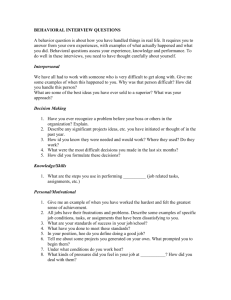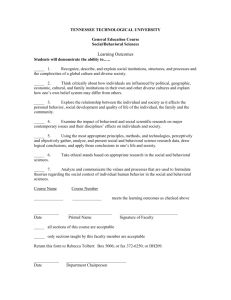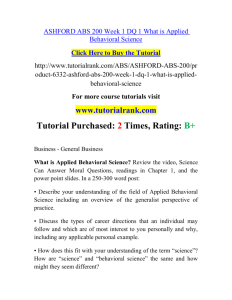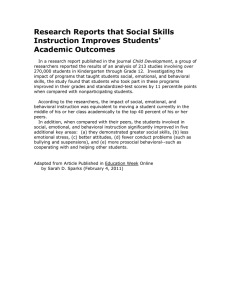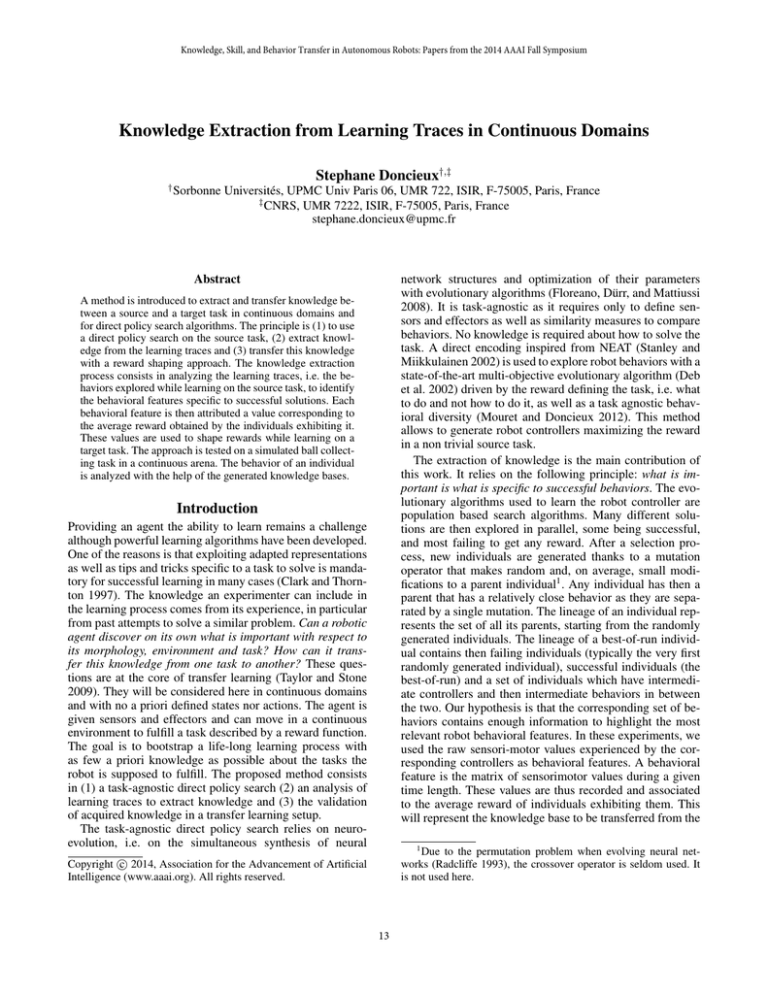
Knowledge, Skill, and Behavior Transfer in Autonomous Robots: Papers from the 2014 AAAI Fall Symposium
Knowledge Extraction from Learning Traces in Continuous Domains
Stephane Doncieux†,‡
†
Sorbonne Universités, UPMC Univ Paris 06, UMR 722, ISIR, F-75005, Paris, France
‡
CNRS, UMR 7222, ISIR, F-75005, Paris, France
stephane.doncieux@upmc.fr
Abstract
network structures and optimization of their parameters
with evolutionary algorithms (Floreano, Dürr, and Mattiussi
2008). It is task-agnostic as it requires only to define sensors and effectors as well as similarity measures to compare
behaviors. No knowledge is required about how to solve the
task. A direct encoding inspired from NEAT (Stanley and
Miikkulainen 2002) is used to explore robot behaviors with a
state-of-the-art multi-objective evolutionary algorithm (Deb
et al. 2002) driven by the reward defining the task, i.e. what
to do and not how to do it, as well as a task agnostic behavioral diversity (Mouret and Doncieux 2012). This method
allows to generate robot controllers maximizing the reward
in a non trivial source task.
The extraction of knowledge is the main contribution of
this work. It relies on the following principle: what is important is what is specific to successful behaviors. The evolutionary algorithms used to learn the robot controller are
population based search algorithms. Many different solutions are then explored in parallel, some being successful,
and most failing to get any reward. After a selection process, new individuals are generated thanks to a mutation
operator that makes random and, on average, small modifications to a parent individual1 . Any individual has then a
parent that has a relatively close behavior as they are separated by a single mutation. The lineage of an individual represents the set of all its parents, starting from the randomly
generated individuals. The lineage of a best-of-run individual contains then failing individuals (typically the very first
randomly generated individual), successful individuals (the
best-of-run) and a set of individuals which have intermediate controllers and then intermediate behaviors in between
the two. Our hypothesis is that the corresponding set of behaviors contains enough information to highlight the most
relevant robot behavioral features. In these experiments, we
used the raw sensori-motor values experienced by the corresponding controllers as behavioral features. A behavioral
feature is the matrix of sensorimotor values during a given
time length. These values are thus recorded and associated
to the average reward of individuals exhibiting them. This
will represent the knowledge base to be transferred from the
A method is introduced to extract and transfer knowledge between a source and a target task in continuous domains and
for direct policy search algorithms. The principle is (1) to use
a direct policy search on the source task, (2) extract knowledge from the learning traces and (3) transfer this knowledge
with a reward shaping approach. The knowledge extraction
process consists in analyzing the learning traces, i.e. the behaviors explored while learning on the source task, to identify
the behavioral features specific to successful solutions. Each
behavioral feature is then attributed a value corresponding to
the average reward obtained by the individuals exhibiting it.
These values are used to shape rewards while learning on a
target task. The approach is tested on a simulated ball collecting task in a continuous arena. The behavior of an individual
is analyzed with the help of the generated knowledge bases.
Introduction
Providing an agent the ability to learn remains a challenge
although powerful learning algorithms have been developed.
One of the reasons is that exploiting adapted representations
as well as tips and tricks specific to a task to solve is mandatory for successful learning in many cases (Clark and Thornton 1997). The knowledge an experimenter can include in
the learning process comes from its experience, in particular
from past attempts to solve a similar problem. Can a robotic
agent discover on its own what is important with respect to
its morphology, environment and task? How can it transfer this knowledge from one task to another? These questions are at the core of transfer learning (Taylor and Stone
2009). They will be considered here in continuous domains
and with no a priori defined states nor actions. The agent is
given sensors and effectors and can move in a continuous
environment to fulfill a task described by a reward function.
The goal is to bootstrap a life-long learning process with
as few a priori knowledge as possible about the tasks the
robot is supposed to fulfill. The proposed method consists
in (1) a task-agnostic direct policy search (2) an analysis of
learning traces to extract knowledge and (3) the validation
of acquired knowledge in a transfer learning setup.
The task-agnostic direct policy search relies on neuroevolution, i.e. on the simultaneous synthesis of neural
1
Due to the permutation problem when evolving neural networks (Radcliffe 1993), the crossover operator is seldom used. It
is not used here.
c 2014, Association for the Advancement of Artificial
Copyright Intelligence (www.aaai.org). All rights reserved.
13
Figure 1: Overview of the proposed approach. The snapshots in the database correspond to robot sensor and effector values
during a given time window.
source task to the target task. It will also provide insights on
the most important features of robot behaviors.
The transfer of knowledge follows the principles of reward shaping (Dorigo and Colombetti 1994; Mataric 1994).
When learning on the target task, the sensori-motor values
experienced by an individual are compared to those of the
knowledge base and the maximum average reward thus extracted is used as a separate objective to be maximized in
a multi-objective setup. The rationale of this approach is to
reward individuals that exhibit the same behavioral features
as those exhibited by successful individuals.
The approach has been applied in simulation to a ball collecting task in a continuous environment.
process has been extensively used in Evolutionary Robotics
where these approaches are called incremental evolution,
behavioral complexification or scaffolding (Doncieux and
Mouret 2014). Transferred knowledge is typically the robot
controller, i.e. the system that computes motors values out of
sensor values (Kodjabachian and Meyer 1997; Mouret and
Doncieux 2008; Bongard 2011). In the proposed approach,
the transferred knowledge is a database of observed behavioral features together with an associated value describing
its relevance with respect to the task. It is thus independent from the formalism used to control the robot. It anyway implies to learn again, instead of relying on previously
acquired controllers, but it has the advantage of providing
insights on robot behaviors and could be used in a cognitive bootstrapping perspective (Windridge and Kittler 2010;
Mugan and Kuipers 2012).
Related work
Can we extract knowledge while learning to solve a source
task and use it to more efficiently solve a target task? This
question is at the core of transfer learning that has drawn a
lot of attention in the machine learning community in general (Pan and Yang 2010) and in reinforcement learning in
particular (Taylor and Stone 2009). The proposed transfer
learning method relies on a shaping reward. It requires to
keep the same agent space, i.e. the same sensors and effectors. This work is thus close to (Konidaris and Barto 2006),
except that there is no problem-space, as the learning algorithm explores directly in the space of policies. Madden and
Howley proposed to transfer knowledge between environments with an increasing difficulty for discrete MDP (Madden and Howley 2004). The goal of this work is similar, but
in continuous domains instead of discrete ones.
Solving problems of increasing complexity while transferring knowledge acquired during each problem resolution
Method
The method consists in alternating between different phases:
(1) learning a new behavior with evolutionary algorithms,
e.g. with neuro-evolution, (2) analysis of learning traces
with the proposed approach (Figure 1) and (3) exploitation
of acquired knowledge in a reward shaping approach. The
second step aims at discovering what is specific to the most
efficient individuals. (Doncieux 2013) proposed to analyze
the behavior of all generated controllers. It is proposed here
to analyze only the lineage of one of the best individuals.
The complexity is thus largely reduced as only a small subset of generated individuals needs to be analyzed.
14
Knowledge building process
The knowledge base KB contains behavioral features bi , together with the average value of reward ri obtained by the
individuals that have exhibited bi :
RSKB (x) = max ({ri |(bi , ri ) ∈ KB ∧ bi ∈ B(x)})
where B(x) is the set of behavioral features exhibited by
the agent controlled by x.
KB = {(b1 , r1 ), . . . , (bKBs , rKBs )|∀i, j, i 6= j ⇒ bi 6= bj }
Experimental setup
with KBs the size of the knowledge base.
The definition of the behavioral features used in the experiments reported here is given in the next section.
The knowledge base building process requires a set of behaviors to analyze. This set is used to identify the behavioral
features and to associate them with a good estimate of their
value with respect to the reward provided to the system. In
(Doncieux 2013), the knowledge base was built out of the
set of all the behaviors generated during the evolutionary
search process. It is proposed here to build KB out of the
analysis of the behavior of individuals that are in the lineage
of a best-of-run. Once a run is terminated, the best-of-run
is then extracted and the algorithm described in Algorithm
1 is executed. Much less behaviors need to be analyzed, resulting in a much faster knowledge building process than in
(Doncieux 2013).
For each behavioral feature the number of individuals that
have exhibited it and the cumulated sum of rewards they
have obtained are recorded. Behavioral feature update consists then in adding the fitness to the cumulated reward and
increasing the corresponding number by one.
Robot, environment and goal-oriented fitness
Algorithm 1 Algorithm of the knowledge extraction process.
I ←best-of-run individual
KB ← ∅
while I 6= N U LL do
Generate I’s behavior and extract:
... f (I) ∈ R, the fitness of I
... B(I), the set of behavioral features exhibited by I
for all b ∈ B(I) do
if b ∈
/ KB then
KB ← add(KB, b)
end if
KB ← update reward(KB, b, f (I))
end for
I ← ancestor(I), N U LL if no ancestor
end while
Figure 2: Simulated arena. The robot has to put balls into
the basket. In the source task used for knowledge building,
all balls are present. In the target task used for testing the
knowledge base, only the ball surrounded by a dashed circle
is present, and it appears only when the switch is activated.
In this new setup, the door is removed. Once this ball has
been collected, a new one can appear if the robot activates
the switch again.
The experimental setup is the same as in (Doncieux
2013). A simulated robotic agent has to collect balls in a
continuous arena and put them into a basket. The robot controller drives the left and right wheel motors as well as the
ball collecting system, that has two modes: collecting balls
or releasing balls. The robot can get only one ball at a time.
It receives one fitness point each time it puts a ball into the
basket. To this end, it must release the ball while in front of
the basket and touching it. In every cases, a released ball disappears from the environment. A switch that the robot can
activate gives access to another room containing other balls.
The environment used for knowledge building is shown in
Figure 2. It contains 8 balls and different rooms. Robot sensors can’t see through walls, so the robot needs to explore the
environment to get fitness points. Robot evaluation is done
on one setup only and for 4000 time steps2 .
The robot has the following sensors:
Knowledge exploitation
The exploitation of the database is done through a reward
shaping approach: when a new individual is generated, its
behavioral features are compared to that of the database.
The maximum value of the set of behavioral features thus
obtained is considered as a separate objective to maximize.
If no behavioral feature belongs to the database, the reward
shaping objective gets an arbitrary negative value (rewards
are always positive). The reward shaping objective RS is
thus defined over a knowledge base KB as follows:
2
in (Doncieux 2013), each robot was evaluated in 3 different
conditions. This modification aims at saving computational time.
15
• 3 distance sensors (continuous value)
• 2 ball detection sensors (front left and front right, binary
value)
• 2 basket detection sensors (front left and front right, binary value)
• 2 switch detection sensors (front left and front right, binary value)
• 2 bumpers (front left and front right, binary value)
• 1 sensor to detect if the robot is carrying a ball (binary
value)
The maximum robot displacement per time step is 4u
(unit of length), the map size is 400 × 600u2 and the robot
radius is 20u.
BD(x) =
y∈P
with P the population for the current generation, N its
size and x, y individuals. dk (x, y) is a behavioral similarity measure. Dynamic behavioral diversity is similar to behavioral diversity (Mouret and Doncieux 2012), except that
the behavioral similarity measure is randomly changed at a
given generation period pg . M different behavioral similarity measures are available (d1 , d2 , . . . , dM ), and at every pg
generation a new value of k is randomly chosen between 1
and M (in this work, pg = 50 generations).
Four different behavioral similarity measures were used:
• adhoc (Ollion and Doncieux 2011): the vector of ball positions at the end of an evaluation is the behavior descriptor and the behavioral similarity measure is the Euclidian
distance between these vectors;
• hamming (Mouret and Doncieux 2012): the behavioral
similarity measure is the Hamming distance between vectors of discretized sensorimotor values ( 60000 bits vector
= 4000 × (12 sensors + 3 effectors));
• trajectory (Ollion and Doncieux 2011): the behavioral
similarity measure is the edit distance between the discretized trajectories of the robots (Trujillo et al. 2011);
• entropy (Delarboulas, Schoenauer, and Sebag 2010): the
entropy is computed for each sensor and effector. For binary sensors, i.e. bumpers, balls, basket and switch sensors, the entropy has been computed as follows:
X ln(pi )
E=−
pi
ln(2)
i=0,1
Behavioral features
The behavior of each individual is split into multiple, fixed
size and non overlapping time windows. The sensorimotor
flow during these time windows is recorded and stored in
m × T matrices, where m = nbsensors + nbef f ectors and
T is the time window length (in the following, T = 20 time
steps). These matrices are the behavioral features that will
be considered to describe robot behavior.
Searching for a behavioral feature in the knowledge base
consists in first looking for the closest matrix in the knowledge base. If the distance to the closest matrix is below a
threshold, then the behavioral feature is considered to be
part of the knowledge base, otherwise, it is considered not
to be part of it. To accelerate the search, the FLANN library
has been used for nearest neighbor search (Muja and Lowe
2009)3 .
Experiments on real robots and with more realistic sensors should consider using more sophisticated behavioral
features, like representations generated by networks trained
with deep learning algorithms (Bengio 2011).
with pi the probability that the corresponding sensor takes
the value i during the evaluation. For sensors and effectors
with a continuous value, the range of possible values has
been divided in ten different subranges and the entropy
has been computed as follows:
Robot controller
The robot is controlled by a neural network whose structure and parameters are explored by an evolutionary algorithm with an approach based on NEAT (Stanley and Miikkulainen 2002), but without using crossover and innovation numbers. Starting from a feed-forward neural network
without any hidden neuron and connecting all inputs to all
outputs, mutations can add or remove connections as well as
nodes. Mutations can also change connection weights. Neuron activation function is a sigmoid function. Corresponding
parameters are given in appendix.
E=−
10
X
i=1
pi
ln(pi )
ln(10)
with pi the probability that the sensor or effector value
belongs to the i-th subrange. The behavior descriptor is
then the vector of the entropies of each sensors and effectors. The corresponding distance is an Euclidean distance
between those vectors;
Dynamic behavioral diversity
List of treatments
Besides the goal-oriented objective that counts the number
of balls put into the basket, a dynamic behavioral diversity
objective was used (Doncieux and Mouret 2013). This objective revealed to significantly improve performance with
respect to behavioral diversity proposed in (Mouret and
Doncieux 2012). The results obtained here confirm these results. The objective BD to maximize measures the distance
between the considered individual x and the rest of the population in the behavioral space. It is thus computed as follows:
3
1 X
dk (x, y)
N
All treatments rely on the multi-objective evolutionary algorithm NSGA-II (Deb et al. 2002). The only difference
between treatments are the objectives optimized during the
evolutionary process. Following the classification of (Doncieux and Mouret 2014), the number of balls is a goaloriented objective, i.e. the only one important at the end of a
run. This is the objective that will be taken into account for
computing average rewards in the knowledge base. Dynamic
behavioral diversity and reward shaping objectives are process helpers whose value at the end of a run is not important
http://www.cs.ubc.ca/research/flann/
16
to decide which individual is the best-of-run. They are only
aimed at making the learning process more efficient.
A single treatment has been considered for the source task
in which two objectives are to be maximized:
1. number of balls;
2. BD: dynamic behavioral diversity.
On the target task, three objectives can be used:
1. number of balls;
2. BD: dynamic behavioral diversity;
3. RSKB : reward shaping objective.
Several runs have been launched on the source task. Because of the stochastic properties of Evolutionary Algorithms, the corresponding best-of-run individuals are not the
same and actually have different fitnesses. Knowledge bases
have been extracted from the lineage of the best-of-run individuals of four different runs that ended up with different
numbers of collected balls. The treatments that have been
considered on the target task are thus the following:
Figure 3: Average number of collected balls of best-of-run
individuals along generations for each treatment (average
over 30 runs).
• KB 1:
– objectives 1, 2 and 3;
– KB1 generated from a best-of-run with a fitness of 7
(balls collected out of a maximum of 8), contains 23734
behavioral features.
• KB 2:
– objectives 1, 2 and 3;
– KB2 generated from a best-of-run with a fitness of 6,
contains 21237 behavioral features.
• KB 3:
– objectives 1, 2 and 3;
– KB3 generated from a best-of-run with a fitness of 5,
contains 23818 behavioral features.
• KB 4:
– objectives 1, 2 and 3;
– KB4 generated from a best-of-run with a fitness of 3,
contains 31421 behavioral features.
Figure 4: Boxplots of the maximum number of collected
balls for each treatment at generation 4000 (30 runs). ’*’
means statistically different with a p − value < 10−2
(Mann-Whitney test), ’**’ means p − value < 10−3 , details of p − values are given in appendix.
• KB1 all:
– objectives 1, 2 and 3;
– KB generated from the same experiment used to generate KB1, but while considering all generated behaviors,
as in (Doncieux 2013) instead of the lineage of the best
of run individual. It contains 60848 behavioral features.
the lineage is then more than 1,000 faster to the one used in
(Doncieux 2013).
Parameters of the algorithm are given in appendix. The
source code of the experiments is available on http://pages.
isir.upmc.fr/evorob db/.
• No transfer (control exp.): objectives 1 and 2.
• KB1 random (control exp.): objectives 1, 2 and 3 with
KB1 in which average rewards have been replaced by random values.
The difference between KB1 and KB1 all lies in the number of individuals used to generate the knowledge base. For
KB1 all, the behavior of all individuals generated during
the evolutionary run is added to the knowledge base, i.e.
800,000 individuals (4000 generations × 200 individuals
generated per generation). For KB1, only the individuals in
the lineage of the best-of-run are used. In this experiment, it
is less than 600. The knowledge building process relying on
Results and analysis
Performance on the source and target task
The experiments on the source task had an average value of
4.25 balls collected (max = 8) after 4000 generations.
On the target task, the knowledge base revealed to significantly improve the learning speed with an asymptotic improvement, at least over the considered budget (Figure 3).
17
(a)
(b)
Figure 5: Trajectory of the best-of-run individual used to generate KB3 colored by the values of the corresponding behavioral
features. (a) values from KB3, (b) values from KB2. Top: trajectory, white means low values and blue high values, the robot is
pictured every 50 time steps in white if the robot does not carry a ball and in red if it carries a ball. Bottom: value with respect
to time steps (-1 means that the value has not been found in the knowledge base). See text for comments on numbered parts of
the trajectories.
This observation is true no matter where the knowledge base
comes from and no matter how it is computed (all individuals or over best-of-run lineage only). The difference is significant after around 1000 generations and even before for
some treatments (see Figure 4 for the performance at generation 4000). The control experiment with a randomized
average reward value is not statistically different from the
experiment that did not use a knowledge base. It means that
the third objective per se can’t explain this difference of performance and thus that the values associated to behavioral
features actually carry some useful information with respect
to the task. It thus validates, at least on this experimental
setup, our knowledge extraction approach.
termediate behaviors may actually be enough to bootstrap
learning. All knowledge bases have been generated out of
individuals able to collect several balls and thus to move
around in the environment, pick up a ball, keep it, look for
the basket and go towards it and then release the ball. Even if
the corresponding behaviors are not all optimal, the knowledge base built from them can recognize and encourage their
generation on the target task.
What is recognized as important?
The knowledge base associates a value to behavioral features. Plotting trajectories colored by the value of the corresponding behavioral feature indicates then what is considered to be important for one particular knowledge base.
Figure 5 shows an example of trajectory for the source
task, colored by the values from two different databases.
When colored by the knowledge base built out of the same
individual, i.e. KB3, all behavioral features have been found
in the knowledge base (by construction) and most of them
have a high value. This is expected as the knowledge in KB3
is associated to the behavior of this particular individual.
The lack of difference between the different knowledge
bases is surprising as one would expect that the knowledge
base associated to a more fit individual would lead to a
higher performance as this base should help identify more
useful information about the robot, its environment and the
task. Anyway, the shaping objective that exploits the knowledge base, aims at bootstrapping the learning process by rewarding stepping stones towards efficient behaviors. Few in-
18
This plot thus highlights the main features of this behavior with respect to close behaviors (in terms of genotypic
distance and thus, to some extent in terms of behavioral distance) that were less successful. Some of them make sense
from a human observer point of view: 1. the robot activates
the switch, 2. the robot picks up a ball, 3. the robot goes towards the basket to drop the ball. Some others are more difficult to interpret, like 4. the robot collides with the wall after
going though the door. This behavior was probably necessary for the navigation strategy of the robot. This particular
feature was for instance not in KB2, whereas 1., 2. and 3.
also belong to KB2 and are associated to high values..
Combining the values coming from different knowledge
bases should lead to the identification of the features that are
salient for the set of behaviors out of which these knowledge bases were built. To this end, it is proposed to associate
to each behavioral feature the product of the values coming from each knowledge base (with 0 when the value has
not been found in the database). Figure 6 shows the result
of such a combination for KB1, KB2 and KB34 . Much less
behavioral features have a non null value and they are easy
to interpret: 1. activating the switch, 2. going towards a ball
to pick it up, 3. entering the second room (discovering the
basket), 4. approaching the basket while carrying the ball, 5.
going back to find new balls after having released a ball.
a consensus between different knowledge bases.
Figure 6: Trajectory of the best-of-run individual used to
generate KB3 colored by the product of the values of the
corresponding behavioral features in KB1, KB2 and KB3.
See text for comments on numbered parts of the trajectory.
Acknowledgement
This work is supported by the ANR CreAdapt project (ANR12-JS03-0009).
Conclusion
The proposed approach allows to extract, from evolutionary
traces, the relative importance of behavioral features with respect to robot features, robot environment and fitness function. The relevance of this knowledge has been validated in
a transfer learning experiment in which a more difficult version of the task has been considered: experiments exploiting
the knowledge base did converge faster and to more efficient solutions. A knowledge base with a randomized value
did not generate the same results, thus confirming the significance of the values attached to behavioral features.
The observation of the values of behavioral features along
a trajectory shows, for one particular behavior, what is considered to be important in the knowledge base. As the knowledge base is built from the lineage of a best-of-run, it is
somehow specialized in recognizing what is important in
one particular behavior. It highlights behavioral features that
are easy to understand from a human observer point of view,
but also features that are specific to the strategy used by
this best-of-run individual to solve the problem. Interestingly, combining the values from different knowledge bases
highlights the features that are shared between all the corresponding strategies and that are thus the more general and
unavoidable to get the reward.
This approach could be used in a cognitive bootstrapping
setup to face the curse of dimensionality and focus the acquisition of new states and actions on the most promising
ones. While the database is still large, future work should
try to reduce its size, for instance by keeping only the behavioral features with the highest values or those that make
References
Bengio, Y. 2011. Deep Learning of Representations for
Unsupervised and Transfer Learning. Journal of Machine
Learning Research-Workshop and Confenrence Proceedings
7:1–20.
Bongard, J. C. 2011. Morphological and environmental
scaffolding synergize when evolving robot controllers. In
Proc. of the international conference on Genetic and Evolutionary Computation Conference (GECCO’11), 179–186.
Clark, A., and Thornton, C. 1997. Trading spaces: computation, representation, and the limits of uninformed learning.
Behavioral and Brain Sciences 57–90.
Deb, K.; Pratap, A.; Agarwal, S.; and Meyarivan, T. 2002.
A fast and elitist multiobjective genetic algorithm: NSGA-II.
IEEE Transactions on Evolutionary Computation 6(2):182–
197.
Delarboulas, P.; Schoenauer, M.; and Sebag, M. 2010.
Open-ended evolutionary robotics: an information theoretic
approach. Parallel Problem Solving from Nature (216342).
Doncieux, S., and Mouret, J.-B. 2013. Behavioral diversity
with multiple behavioral distances. 2013 IEEE Congress on
Evolutionary Computation 2013:1427–1434.
Doncieux, S., and Mouret, J.-B. 2014. Beyond Black-Box
Optimization: a Review of Selective Pressures for Evolutionary Robotics. Evolutionary Intelligence 1–23.
Doncieux, S. 2013. Transfer Learning for Direct Policy
Search : A Reward Shaping Approach. In Proceedings of
the IEEE ICDL-EpiRob conference.
4
KB4 has been neglected as the corresponding behavior did not
use the switch.
19
Windridge, D., and Kittler, J. 2010. Perception-action
learning as an epistemologically-consistent model for selfupdating cognitive representation. Advances in experimental
medicine and biology 657:95–134.
Dorigo, M., and Colombetti, M. 1994. Robot shaping :
developing autonomous agents through learning. Artificial
intelligence 71:321–370.
Floreano, D.; Dürr, P.; and Mattiussi, C. 2008. Neuroevolution: from architectures to learning. Evolutionary Intelligence 1(1):47–62.
Kodjabachian, J., and Meyer, J. A. 1997. Evolution and
development of Neural Networks Controlling Locomotion,
Gradient-Following, and Obstacle-Avoidance in Artificial
Insects. IEEE Transactions on Neural Networks 9:796–812.
Konidaris, G. D., and Barto, A. 2006. Autonomous shaping: Knowledge transfer in reinforcement learning. In ICML
’06 Proceedings of the 23rd international conference on Machine learning, 489—-496. ACM.
Madden, M., and Howley, T. 2004. Transfer of experience
between reinforcement learning environments with progressive difficulty. Artificial Intelligence Review (1986):375–
398.
Mataric, M. 1994. Reward Functions for Accelerated Learning. In ICML ’94 Proceedings of the 11th international conference on Machine learning, 181—-189. Morgan Kaufman.
Mouret, J.-B., and Doncieux, S. 2008. Incremental Evolution of Animats’ Behaviors as a Multi-objective Optimization. In From Animals to Animats 10, volume 5040, 210–
219. Springer.
Mouret, J.-B., and Doncieux, S. 2012. Encouraging Behavioral Diversity in Evolutionary Robotics: An Empirical
Study. Evolutionary computation 20(1):91–133.
Mugan, J., and Kuipers, B. 2012. Autonomous Learning
of High-Level States and Actions in Continuous Environments. IEEE Transactions on Autonomous Mental Development 4(1):70–86.
Muja, M., and Lowe, D. 2009. Fast approximate nearest
neighbors with automatic algorithm configuration. In International Conference on Computer Vision Theory and Applications (VISAPP’09), 331–340.
Ollion, C., and Doncieux, S. 2011. Why and How to Measure Exploration in Behavioral Space. In GECCO ’11: Proceedings of the 13 th annual conference on Genetic and Evolutionary Computation, 267–294.
Pan, S. J., and Yang, Q. 2010. A Survey on Transfer Learning. IEEE Transactions on Knowledge and Data Engineering 22(10):1345–1359.
Radcliffe, N. J. 1993. Genetic set recombination and its
application to neural network topology optimisation. Neural
computing and applications 1(1):67–90.
Stanley, K., and Miikkulainen, R. 2002. Evolving neural networks through augmenting topologies. Evolutionary
Computation 10(2):99–127.
Taylor, M., and Stone, P. 2009. Transfer learning for reinforcement learning domains: A survey. The Journal of Machine Learning Research 10:1633–1685.
Trujillo, L.; Olague, G.; Lutton, E.; Fernández de Vega, F.;
Dozal, L.; and Clemente, E. 2011. Speciation in Behavioral
Space for Evolutionary Robotics. Journal of Intelligent &
Robotic Systems 64(3):323–351.
Appendix
Statistical significance of the results on the target task (Mann-Whitney test) at generation 4000:
No tr.
KB1 r.
KB1 all
KB1
KB2
KB3
KB4
No transf.
1
0.1248
<10e-2
<10e-3
<10e-2
<10e-2
0.026
KB1 r.
0.1248
1
<10e-4
<10e-6
<10e-4
<10e-4
<10e-3
KB1 all
<10e-2
<10e-4
1
0.043
0.34
0.44
0.29
KB1
<10e-3
<10e-6
0.043
1
0.020
0.039
0.016
KB2
<10e-2
<10e-4
0.34
0.020
1
0.40
0.41
KB3
<0.01
<10e-4
0.44
0.039
0.40
1
0.33
Parameters of the knowledge extraction process:
• Time window length, T = 20
• Threshold for matrix distance, 1.83
Parameters common to all the treatments:
• MOEA: NSGA-II (pop. size : 200)
• DNN (direct encoding):
– number of neurons∈ [10, 30]
– number of connections ∈ [50, 250]
– prob. of changing weight/bias: 0.1
– prob. of adding/deleting a conn.: 0.15/0.05
– prob. of changing a conn.: 0.03
– prob. of adding/deleting a neuron: 0.05/0.05
– activation
function for
P
neurons:
1
yi = ϕ
w
x
where ϕ(x) = 1+exp(b−x)
ij
j
j
20
KB4
0.026
<10e-3
0.29
0.016
0.41
0.33
1



